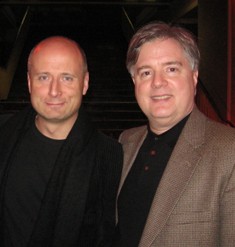
Paavo Järvi and Philip Traugott
|
Although Traugott and Järvi had been friends for years, it was not until 2004 that they recorded together. In fact, Paavo was the last member of the Järvi family to work with Traugott.
How he and Järvi met is a story in itself, beginning on the steps of the Juilliard School and continuing in Morgantown, West Virginia.
“I took an audition for Juilliard as a conductor,” said Traugott. "There was this young lady, who also took the audition and she had a striking black leather, one-piece suit on, like she had come in on a motorcycle or something. Later that day, I was waiting for the 104 (bus) and lo and behold the same girl passed me. We had a little conversation about the audition and she said, ‘You should look into this Conductor’s Guild that Harold Farberman is the director of.’”
The girl was Marin Alsop (music director of the Baltimore Symphony Orchestra).
“That little conversation changed my life. As a result of Marin, I went to the conducting school (at West Virginia University in Morgantown) and in the room next to mine was this young, wild kid named Paavo Järvi. He was already spectacularly talented, with charisma to spare, the likes of which most of us didn’t have, and yet also a kind of a wild child. He was undisciplined and running around and having so much fun and we all really loved that as well. He and I connected instantly -- to use the Strauss waltz melody, ‘Wine, Women and Song,’ not necessarily in that order. We loved those three things in the same way.”
The two have remained friends, though even after Traugott became a successful recording producer, they did not work together professionally.
“When his career was
starting to take off and I was at BMG, he was saying, ‘You know, we should
record together.’ I was thinking, ‘That
would be fun, but I don’t want to jeopardize our friendship. If it doesn't work out, it could be a problem. We're having too good a time as friends.'"
Besides that, Järvi was already recording (Virgin Classics) and had a producer. "He was a little bit chagrined, I think, but he kept bringing it up.
"Then, within weeks of one of those conversations, I sat down at my desk at BMG and there was a list of projects ahead of me. One of them was doing a recording with (violist) Yuri Bashmet and the London Symphony Orchestra. The conductor was going to be Neeme Järvi. I said to myself, ‘Oh my god, you’re kidding me.’ It’s one thing to work with Paavo or Kristjan, but starting with Neeme Järvi?’
“I also hadn’t worked with the LSO so often. I did a little bit with Andre Previn, but I just wasn’t that experienced. I approached this project with a bit of trepidation because this is also the father of my best friend.”
Traugott did the sessions with Bashmet and Järvi (works by Max Bruch for viola and orchestra). “What was really amazing was that because Neeme Järvi has so much confidence, experience in recording (over 300 recordings at the time), let alone on the podium and everywhere else, that he made me feel completely at ease. I was able to just do my work and not worry about anything else. He has a little wink in his eye, a little smile that is totally disarming, and I just felt great. ‘Let’s get down to work’ and we did.”
After that, Traugott recorded with Kristjan Järvi (Paavo’s younger brother).
“Kristjan had started his Absolute Ensemble and wanted to record Mahler’s Fourth Symphony (the chamber version by Erwin Stein). He made it in one session. We started at noon and except for a pizza break, we finished at 2 a.m., a 14-hour session.
“The next thing you know, I get a phone call from (flutist) Maarika Järvi, who was also an old dear friend (sister of Paavo and Kristjan). She had a duo, Martinika, with bassoonist Martin Kuusksman, and they wanted to record. I thought, ‘well, it worked out with Kristjan, I guess it’ll work with Maarika.’ We went up to a church in New Rochelle and did the recording, which turned out fine as well.”
What Traugott discovered, he said, was that “we all knew each other and were completely comfortable. There was no issue of, 'are we going to get along?’”
The one person he had still not worked with was Paavo. “I had trepidations about doing anything with him because he really was my closest friend.”
Then his telephone rang again. “It was about doing this Beethoven cycle with Paavo and I thought, ‘uh, oh, here it is.’ We had talked about this. Are we going to subject our 17-year friendship to a recording session? What if things don’t go well? It could be maybe one of us doesn’t hold the other up to as high a standard, or feel respect to each other as much as we used to, or we get into a fight. I mean anything can happen.”
As it happened, before that phone call, Traugott had been working with pianist Ikuyo Nakamichi for BMG Japan. “She wanted to record the Beethoven piano concertos with Paavo and the Deutsche Kammerphilharmonie, so that actually was the first recording. As a result of those sessions, Paavo was very enthusiastic about our relationship. I was greatly relieved that we got along really well. At the end of the piano concerto sessions, we went to Berlin and recorded the 7th Symphony. That’s when the cycle started.”
Traugott and Järvi have forged a working relationship that recognizes and makes the most of each other’s talents, including Traugott as conductor. “He asked me to lead not only the sessions, but the orchestra in these rehearsals. The orchestra was a bit surprised at first, but they began to really like it. There’s a real strategy behind the decision to work that way.”
Their procedure is for Traugott to rehearse the orchestra from the control room. “The premise is a little bit of the good cop/ bad cop situation where Paavo doesn’t have to criticize members of the orchestra when they’re playing. I do, but I do it in a very constructive way. I was a musician and violinist myself, so I have huge respect for what musicians do, particularly when you have those microphones sticking in front of them. It’s very hard, so whatever I discuss with them must be with the utmost respect, and they know and appreciate that. They’ve learned to trust that it gets a result quickly.”
Traugott tells the orchestra exactly what the problem is. “I learned this from Andre Previn and the LSO. When I stopped them for something, he said 'tell us exactly what is wrong.’ He put me on the spot and, of course, the LSO loved it. They wanted to see the producer squirming in his chair. So I had to start going down the list of what the things were. This is something we also learned in the Conductor’s Guild. When you stop an orchestra, you have to be able to tell them what the issue is, not ‘let’s go back to the beginning and do it again.’”
Traugott learned these techniques from conducting. “I learned them from my teachers, from conducting, from whatever, and they have all come to inform my work as a producer.”
Working this way saves time, energy and perhaps most crucially, focus, said Traugott. “I work with the orchestra in this very technical fashion, getting things to a kind of white heat in terms of their performance ability, and Paavo stays in performance mode. When I call the next take number, he is still in that performance mode. He hasn’t had to get out of that focus and get into the ‘B-flat,’ ‘late 8th note,’ ‘imbalance in the horns’ kind of thing.
"He's very happy. He can keep his vision on the longer line, the mood, the energy he wants to keep, the atmosphere he wants to create, or characters he wants to bring out. He can keep his mind on the musical stuff and he’s ready to pounce the minute I’m finished doing my corrections. We work as a team so that when the next take is called, you get the best of both. Later, when I edit those sections together, you have everything, the music going all the way through it, the details going through it, it’s in tune, it’s together and it’s balanced.”
In November (2009), Traugott did Järvi’s first recording with the Orchestre
de Paris, where Järvi becomes music director in 2011-2012. “It hasn’t
been edited yet, music of Bizet, two symphonies and the ‘Jeux d’enfants.’”

In Paris, as elsewhere, orchestras can tell immediately if he and Järvi have rapport, said Traugott. “There’s a humor there, a connection that orchestras really like because they feel very comfortable. They feel comfortable therefore with the way I work with them directly, the way I do this rehearsal business. It’s again largely because of the way we work together, the comfort level and the fact that we’re both very super-organized, efficient and get things done.
“There nothing better for an orchestra than getting results from them on tape that make them sound great forever. They love it.”